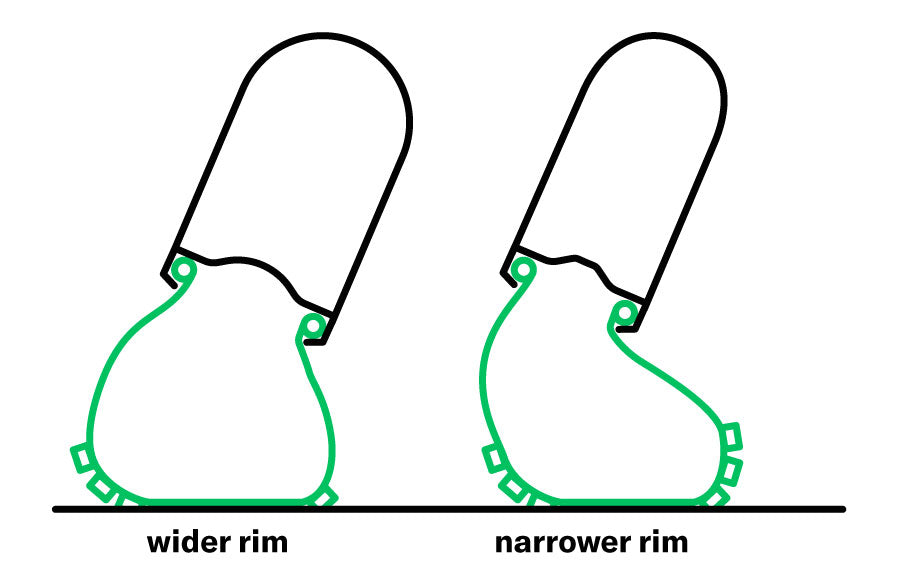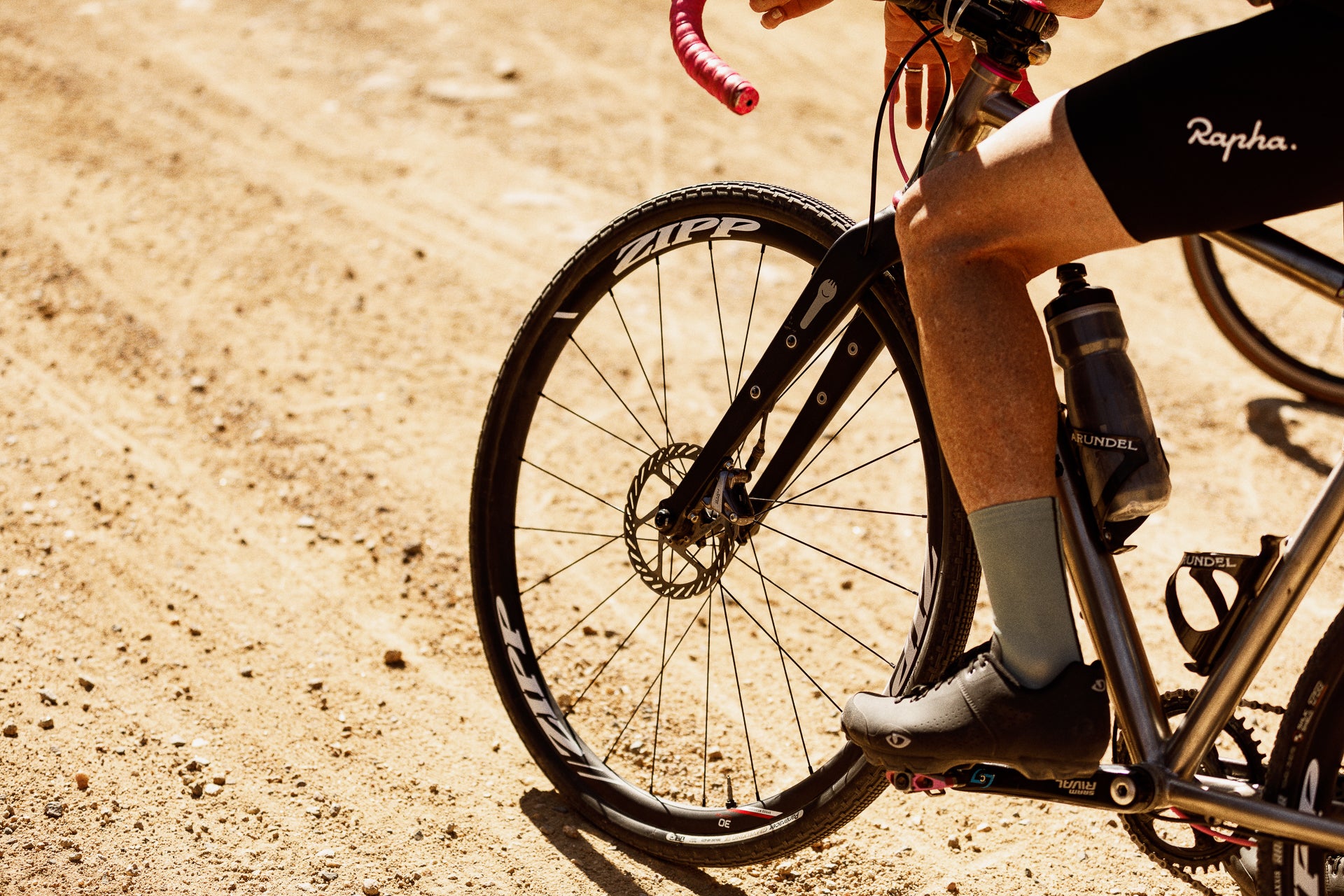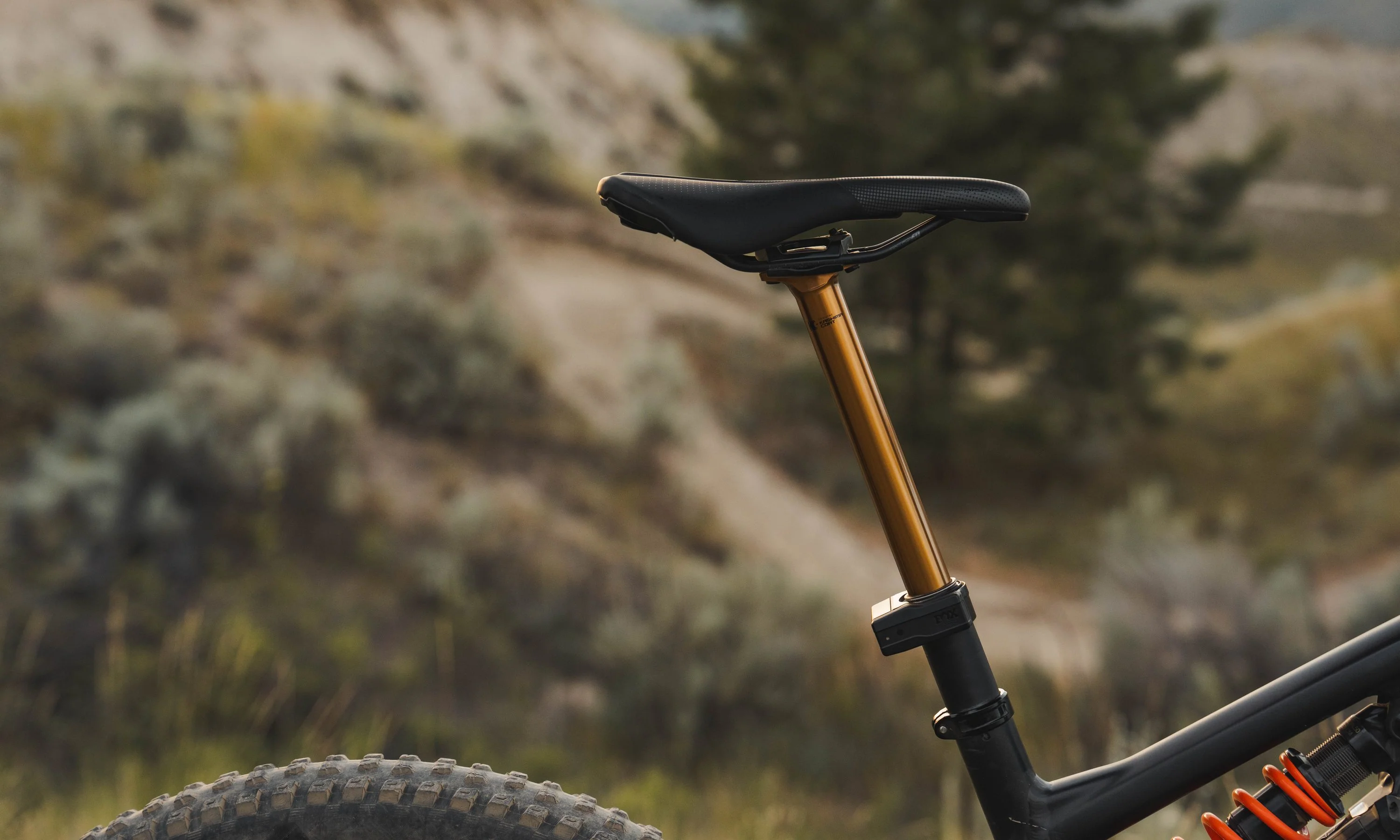We used to not worry about rim width. For years, my wheels were the same, season after season — I rode 14mm-wide rims on my road bikes and 19mm-wide rims on my mountain bikes (internal width).
But around 2014, I started noticing new and interesting wheels coming into the shop. These wheels were wider. Not truly wide like they are today, but 18mm road wheels and 25mm (internal width) mountain bike wheels were a big change. At the time, they seemed massive compared to what I was riding.
One day, I bought a set of 23mm-wide Derby rims for my gravel bike and never looked back. I'm here to tell you that wide is the way to go! Plus, I've got some experts from ENVE, Stan's, and Industry Nine to back me up on this. Read on to learn more.
[button]SHOP WHEELS[/button]
What is inner rim width?
First things first, what are we talking about when we say "rim width?" For our purposes, we’re specifically interested in inner rim width. This measures the internal distance between the rim walls. Most wheel manufacturers will list the inner width specs of their rims. (You don't usually worry about external width, unless you're concerned about aerodynamics in road wheels.)
In the last 10 years, rim widths have grown tremendously. It’s common for modern rims to have around 21mm internal width for road and 30mm internal width for mountain. There’s now a huge range of wide rims from every manufacturer.
You may have heard all the marketing hype about why you need to be riding wider rims. But I was interested in going a bit deeper and learning what has driven manufacturers to keep going wider and wider. I tracked down a few wheel experts — Jake Pantone of ENVE, James Malta of Stan’s NoTubes, and Jacob McGahey of Industry Nine — to get their take on why wider is better.
[newsletter]
Why did rims start getting wider?
Rim width had remained fairly static for a long time. Road bike rim width was 13-15mm for decades, and MTB rim width was usually 19mm.
“For the first mountain bike rims, people were taking road rims, cutting them, and rerolling them,” explains James Malta of Stan’s NoTubes. “19mm internal rims pretty much became the standard then because that’s what we had. By the '90s and early '00s, there was a bit of variety, but mountain bike tire manufacturers were mainly still designed around a 19mm rim. Then in the mid-2000s, we started to see wider rims like the Sun DoubleWide and Rhyno Lyte gaining popularity in the gravity world.”
Malta ties this growth in MTB rim width directly to the advent of tubeless technology in mountain biking.
“Tubeless allowed you to run lower pressures,” he says. “Wider rims give better tire support at low pressures, so we’ve fully embraced that since we started making rims in the mid-2000s. In 2007, when we were relatively new at making rims of our own, we came out with the Freeride rim. It had a 26.1mm internal width, which was unusual at the time.”
 Upgrading to a wider rim provides more support for the tire's sidewalls with low-pressure tubeless setups. This will improve cornering at low pressures by reducing a tire's tendency to roll off the rim. All this works together to improve traction and comfort.
Upgrading to a wider rim provides more support for the tire's sidewalls with low-pressure tubeless setups. This will improve cornering at low pressures by reducing a tire's tendency to roll off the rim. All this works together to improve traction and comfort.
Jacob McGahey of Industry Nine gives a similar assessment and adds that improvements in rim manufacturing and materials facilitated these changes.
“Traditional rim designs didn't offer enough support for the wider tire casings and lower pressures,” he says. “So it was really a matter of updating rim design to match the performance of modern tires. The ability to make wider rims was precipitated by an industry shift to higher-strength rim materials including improved alloys (such as the 6069 aluminum or similar) and the evolution of carbon fiber rims with better resin systems and processing. These technologies offer higher strength-to-weight ratios and allow wider rims without a significant weight or strength penalty.”
Jake Pantone of ENVE also credits the introduction of disc brake technology.
“Disc brakes ushered in a new era of rim innovation opportunities,” he says. “Before disc brakes, engineers had to work within rim brake caliper clearance. With the constraint of rim brakes removed, rim designers have been able to start innovating. There’s a variety of other reasons too — aerodynamic efficiencies, more user-friendly/reliable tubeless performance, and rim/tire interface optimization for handling characteristics, and rolling resistance reduction.”
[button]Shop ENVE Wheels[/button]
How do wheel manufacturers settle on specific inner rim widths?
Ultra-wide rims didn’t just appear overnight. In most cases, manufacturers took small steps, incrementally increasing the width of their rims, testing and refining for years until we reached our current widths.
“For road rims, it’s all about the aerodynamics and stability,” Pantone explains. “We consider the intended tire size and design around that. The rim’s width is determined after testing first in CFD (Computational Fluid Dynamics), then the wind-tunnel. The fastest testing candidates then get made into rideable prototypes, and whichever rim shape/width rides and handles the best goes to production.
“Mountain/gravel rim width is determined primarily by intended tire size/volume. There are a lot of subjective opinions on this matter, but we’re looking for a rim width that provides ample tire support. In other words, we try to be as narrow as possible without compromising tire support. Going wider with a mountain rim adds weight exponentially compared to adding depth. So, it’s all about finding the right balance of width and weight.”
Is your tire the right width for your wheel's inner rim width?
With so many rim and tire options on the market, it’s easy for riders to get lost in the weeds trying to determine the ideal combination for their bike. Fortunately, many wheel companies provide recommendations for tire widths that will be optimal for their rims. Each brand's recommendations may vary, but this chart generally shows the optimal combinations of tire widths and rim widths.
| Riding style | Tire size | Inner rim width |
| Road | 25-28mm | 18-21mm |
| Gravel | 30-45mm | 21-25mm |
| Adventure | 40-50mm | 25-30mm |
| Cross-country MTB | 2.1"-2.3" | 25-30mm |
| Trail MTB | 2.3"-2.5" | 30mm |
| Enduro MTB | 2.4"-2.8" | 30-35mm |
Stan’s NoTubes, for example, uses WideRight to guide their customers in their wheel and tire purchasing decisions.
“WideRight is a guideline for what we design around and what we consider optimal,” Malta says. “For current mountain bike tires and wheels, we essentially recommend around a 2.1:1 to 2.2:1 ratio. A little more than half. This doesn’t mean you can’t paint outside the lines though. One tire brand’s 2.5” tire and another brand’s 2.5” might be very different. There are variances.”
[product-block handle="stan-s-notubes-ztr-grail-mk3-aluminum-tubeless-wheelset"/]
For mountain bike wheels and tires, ENVE’s recommended tire to wheel ratio is essentially the same as Stan’s NoTube’s.
“On the mountain side, our tire size recommendations are basically 2.0-2.3X the inner rim width,” Pantone says. “In other words, we recommend a 2.4-2.5” tire for a 30mm internal rim, 2.8” for a 35mm internal rim, and 3.0” for a 40mm internal rim. It can be confusing for consumers. We do our best to make recommendations on the product pages.”
McGahey adds, “From an engineering perspective, tire manufacturers design each tire around a specific inner rim width, but they don't typically publish this. Taking this into account, we list a suggested range of tire widths for all of our rims on our website, which is based on what we find typically works well."
We’ve seen some tire brands like Maxxis begin to tackle this issue. Its “Wide Trail” mountain bike tires are designed specifically to suit rims with an internal width of 30-35mm.
Malta also wanted to clear up one misconception many riders have about switching to wide rims. Contrary to the online comment strings, a wider rim will not increase the volume of your current tires.
“People say you get more volume out of a tire, but that’s not quite accurate because the casing stays the same,” he explains. “The tire doesn’t get physically bigger. You may get a bigger caliper measurement side-to-side, but what you are seeing is that the tire is distorted and the 'aspect-ratio' has changed. Wider rims just spread that casing out.”
This is to say, if you’re getting wider rims, you need the tires to match.
“In general wider tires require wider rims and vice versa,” McGahey says. “The popular 30mm rim certainly isn't a catch-all option for all types of riding and tires, so there will always be room for narrower rims for a given application.”
[button]SHOP TIRES[/button]
Will rims continue to get wider?
If you’re concerned about jumping on the wide-rim bandwagon only to see standards change yet again, no need to worry. All of our wheel experts generally agree that rims widths are becoming standardized.
“I think we’re getting closer to an ideal,” Malta says. “There are limits, and the industry tends to go to extremes. But we’re coming back to a bit of normalcy. Speaking to various tire and rim manufacturers, where we seem to be settling on for the near future is not too far off of our current WideRight numbers.
“Further beyond that, who knows? There’s always room for improvement and innovation,” he adds. “Today's tire inserts could be a Bandaid until tire and rim technology catches up to how people are riding. Maybe a wider and shorter tire could be an option as opposed to tall and flexible, but right now we’re not producing tires like motorcycle tires that have more structure in the tire. With technology right now that’s not a possibility. But there could be a lot of opportunities there”
 Pantone says the evolving segment of gravel bikes is potentially the only genre of cycling where rim width could still see some change.
Pantone says the evolving segment of gravel bikes is potentially the only genre of cycling where rim width could still see some change.
“Gravel seems to be the one area where more width may come about, but not for the existing 40-42mm tire standard,” he says. “We may have to go wider to accommodate gravel riders who are venturing into the 50-55mm tire realm. For ENVE, adding width typically adds more weight than any other geometric adjustment to the rim. So it’s about striking the perfect balance. There is a point where you’re just too wide and the tire will be compromised, as well as other performance characteristics.
“Today, we know where the diminishing returns are for aerodynamics as they relate to tire width. We know that plus-size mountain bike tires and fat bike tires aren’t really for everyone all the time. And our sales data is telling. We’ve offered a 30mm, 35mm, and 40mm rim width in our M6 Series mountain wheels for going on three years now. Each year, we are selling more wheels as a whole, but each year we sell more 30mm rims than 35mm or 40mm rims. I may be eating my words 10 years from now, but I’d say we’ve found the extremes and are rapidly closing in on ‘ideal.’”
McGahey points out that there are a few small product changes that may continue to come, but big shifts like we’ve seen in the last 10 years likely won’t.
“While we have a few new products coming out that are slightly wider than previous models, this is mainly due to the tires in these categories going wider (for gravel and XC for instance). Overall, we don't anticipate any major shifts in our rim inner-widths. We are constantly evaluating tire technology to make sure our rims are designed to work with the popular tires on the market, but feel really good about where our rims are positioned in relation to current tire design trends and don't foresee any significant changes coming in the near future.
“I would say that for the current popular tire widths for specific applications (road 25-30mm, cross/gravel 33-50mm, MTB 2.25-2.8”) I think we are reaching the limit for internal width. There will certainly be some outliers, but I don't anticipate any more major shifts towards much wider rims unless the tires get much wider for those categories.”
What are the potential disadvantages of rims that are too wide?
If a little bit of something is good, then a lot must be better, right? This isn’t the case with rim width. Manufacturers and riders have discovered some disadvantages to pushing the limits of width. Going wider is good, but what will riders sacrifice by going too far?

Image courtesy of Stan's NoTubes
“When you start to go to a wider base than the tire was designed for, you get the 'bell' shape,” Malta explains. “You start to distort the casing and tread. The side knobs aren’t where they’re supposed to be. You also lose the tire sidewall’s natural protection over the rim. You’ll start to cut more tires and ding rims more.”
Weight is the other issue. Wider rims weigh more than narrower rims of the same material.
“In order to maintain the needed strength for a rim, wider rims require more material,” McGahey explains. “Taking this into account, at some point there is a diminishing return on going wider as the rims will start to get really heavy without a real benefit.”
How much difference will 1mm of rim width make?
If you’re shopping for new wheels, you might end up comparing rims that differ in width by only 1-2mm. How much of a difference will that 1mm of width really make? Is there any need to obsess about such a small difference between rims?
“If you can ride a 29mm and a 30mm [internal width] rim and tell the difference, I will eat my hat,” Malta says. “Basically, no.”
Pantone and McGahey largely agree with Malta's assessment.
“We test ride a lot of rims,” Pantone says. “1mm one way or the other is really hard to see or feel. 2mm is a bit more noticeable. Then 5mm is very meaningful.”
“This one really depends on the rider and tire,” McGahey says. “Most riders won't be able to tell the difference in a 1mm width change. However, if a tire is really at the edge of its operating range, a sensitive rider might notice a subtle difference. However, there are so many other variables to consider that I would encourage riders not to get hung up on rim differences of 1mm or less.”
[product-block handle="industry-nine-i9-35-carbon-wheelset-xdr"/]
Is there still a place for narrower rims in cycling?
So we know a wide rim can greatly enhance your riding experience by improving tire support with low-pressure tubeless systems and wider modern tires. But do you need to ditch your current wheels immediately?
“It depends,” Malta says. “Say you’re running an old school narrow tire like a 1.5-1.9”. It’ll probably be happier on a 19mm rim. Whether there’s still a new market for that remains to be seen.”
Pantone says there is one place that’s the perfect for narrow rims, “TPC’s Museum!”
 Back in the day, you had to go to great lengths to find wider rims! Read about this unusual "fat bike" in our Bike Museum.
Back in the day, you had to go to great lengths to find wider rims! Read about this unusual "fat bike" in our Bike Museum.
Have you made the switch to wider rims? Why or why not? What's your ideal rim width for your riding? Let us know in the comments!


























